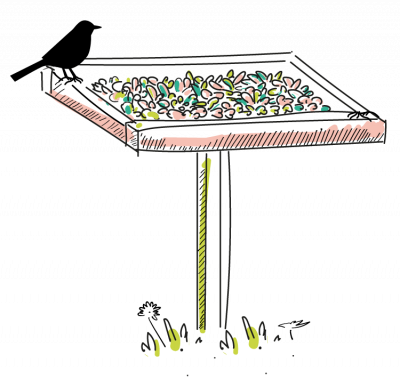Building and installing a feeder

Building and installing a feeder
Species likely to benefit from this action:
Action efficiency:
Cost of action:
Level of complexity of the action:
Durée pour voir une évolution de la biodiversité :
Type d'établissement où mener l'action :
Why take this action?
Birds are animals that regulate their own body temperature (homeothermic) by producing heat (endothermic), in order to keep their bodies at a constant temperature... just like us humans! Yes, you may have noticed that we have certain body reactions that allow us to produce heat when it is cold, such as shivering. However, most of us spend the winter months in heated homes or covered in thick clothing, which saves us some of this energy expenditure. This is not the case for most other mammals and birds. They therefore need a high energy intake during cold periods to maintain their temperature around 40°C. This is no mean feat... as food resources are rather scarce at this time!
To help birds get through the winter, you can build and stock a feeder
The foreseeable benefits of this action :
A feeder ensures a regular supply of food for the birds during the winter.
Vous pouvez obtenir des planches de bois à partir de palettes européennes (elles peuvent être récupérées dans les magasins par exemple).
Attention ! Assurez-vous que votre palette contient l'inscription HT (haute température) entre les inscriptions EPAL et EUR. Si vous voyez l'inscription MB, ne l'utilisez pas, elle a été traitée au bromure de méthyle, un fumigène très toxique pour l'environnement. En général, faites attention aux traitements qui ont pu être appliqués au bois.
People to notify
In order to set up the feeder, you need the authorisation of several people (the headmaster or principal of your school, the administrator).
Don't hesitate to talk to your life science teachers!
In the resources section, you can download a model letter to complete, which you can send to the adults in charge to explain your project. We also suggest you print posters to communicate about this action in your school (see resources section).
Budget to plan
If you plan to buy wooden boards you will need to budget for the cost of the board (about €20). If you build your feeder from recycled materials, then you don't need to budget for anything.

How to do it concretely?
Choose a location
The feeder should be placed in a quiet, low-traffic area, if possible near trees, bushes or bird hiding places. Many birds will approach the feeder slowly at first, or like to take their seed with them to eat it under cover. Finally, a feeder is a place for observation, so it is ideal to install it in a place where it is possible to see the birds without scaring them (behind a window for example).
Building the feeder
You can build and install your feeder in the autumn, or at least during the first term of the school year, so that it can be visited by birds during the winter.
There are several ways to build a feeder! For example, you can hang up a container filled with seeds (a flower pot cup, half a grapefruit, a tin can with a wooden spoon, a plastic bottle with a hole in it...). )... Here we will only describe how to build a wooden feeder
Take an inventory immediately after setting up your feeders:
Carrying out Vigie-Nature School protocols will allow you to know if your actions have an effect on biodiversity! Think about making inventories (Oiseaux des jardins) before you start installing the feeder, so you can check whether the presence of birds is increasing.
For each of our protocols, you have to define an observation area that allows the researcher to know the context in which you are making your observations. For some of these protocols, you will be asked if any species are present, so remember to update this information if these species appear in your fallow land (nettles or brambles for example).
Supply your feeder regularly (at least twice a week)
Fill your feeder at least twice a week (sunflower and hemp seeds, oatmeal, sultanas, fruit, chopped nuts or hazelnuts, vegetable fats are good choices). Before putting down fresh food, remember to brush away uneaten seeds and bird droppings to avoid spreading disease.
Document the evolution of biodiversity!
Regularly observe the birds, you can use l’application BirdLab to help you identify them, or even to make a protocol if you make two feeders (look carefully at how to position them). Each time you visit, you can note down the date and the species present, and take photos of them... This will allow you to follow the evolution of their visits. Don't hesitate to ask for help from adults in the school, such as your science teacher.